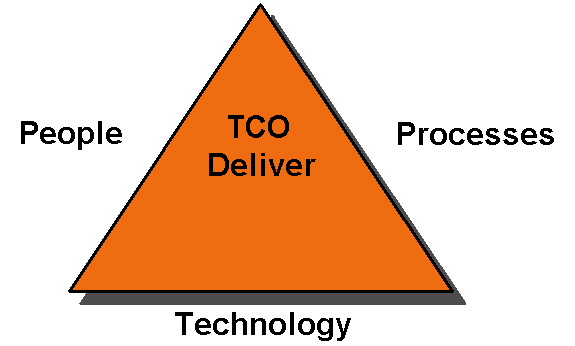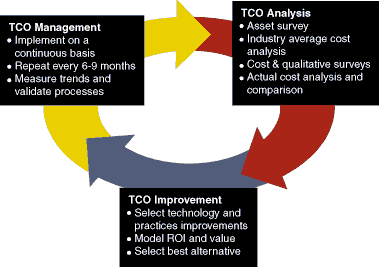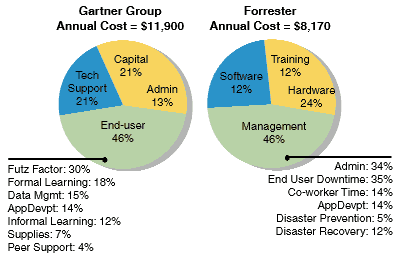| Overview |
|
Total Cost of Ownership (TCO) has been being applied and constantly improved in the information technology landscape since 1987, when Bill Kirwin, vice president and research director at Stamford, Conn.-based Gartner Group Inc,. first applied the model to desktop systems. The model has since extended into LANs, client/server software, distributed computing, telecommunications, mainframe data centers, Windows CE and Palm OS handheld computers. TCO models for storage technology and applications developments are the expecting ones sooner or later.
|
| Balance of TCO Primary Driving Factors |
|
Compaq, which embraces Gartner Group's TCO approaches, states that organizations reduce IT lifecycle costs most effectively when they make three complementary investments: training people, streamlining processes and acquiring technologies that are easy to manage, service and support.
Companies that aggressively implement such initiatives report large gains in IT efficiency and, as a result, significant reductions in TCO. For best results, as suggested by Compaq, a balanced focus is required on all three primary factors driving TCO:
The Three Main Primary Factors Driving TCO
|
| Gartner Group TCO Lifecycle Model |
|
Right TCO model for each specific organization
Several research groups, such as Gartner, and Forrester, provide different TCO models for different types or scopes of organizations. Before making changes and investments in the three primary areas, including people, processes and technology, managers should start by evaluating people, processes and technology using a comprehensive TCO model that is right for their specific enterprise.
Gartner Group TCO Lifecycle model
This model is often used for assessing IT costs and associated operational processes. Utilizing this model reveals IT operational costs and provides a method to routinely capture and reduce them. Many companies using this approach also report that it is easier to implement change by raising awareness throughout the enterprise that IT costs can and must be controlled.
Gartner Group TCO Lifecycle Model (Source: Compaq)
Benefits of the Lifecycle Model
In order to implementing a TCO Lifecycle Model requires the following:
The benefits in the TCO analysis using Lifecycle model are:
|
| Gartner Group PC/LAN TCO Model |
|
The Gartner Group developed its first TCO model for PCs in 1987, in order to provide a framework for enterprises to understand TCO costs. The model has been maintained as proven comprehensive life cycle cost model to identify and reduce costs and to evaluate end-user computer (EUC) investment decision. As local area network (LAN) proliferation intensifies throughout enterprises, Gartner Group developed the Corporate LAN Cost of Ownership Model in 1993.
PC Cost Model
The Gartner Group model was based on information and data from medium-sized US companies with about 2,500 (Windows 3.1) PCs, located in a single campus environment. The capital cost of these systems is based on the “street price” in the year purchased and is represented as a “composite” system cost. The model assumes multiple generations of Intel PCs.
LAN Cost Models
According to Gartner Group, the TCO of distributed computing fluctuates based on the level and type of technology employed. For example, the 1987 PC TCO model indicated the five-year TCO was $19,296 for a DOS-based PC in a typical enterprise. In 1996, the cost rose to $44,250, which was a 129 percent increased in nine years. Moreover, as more new technologies and capabilities become available each year, this would also make the need to understand complex environment. Support costs and other hidden costs have grown beyond anyone’s expectations.
Gartner Group has also accessed the impact of key technologies on the PC/LAN Model as below:
|
| Gartner Group New TCO Models |
| Gartner Group have been constantly updating TCO models to meet different scenarios in different organizations. Such models are the tools that facilitate the collection and measurement of direct and indirect IT costs and service levels, allowing managers and users to analyze and manage a wide range of cost and risk-related issues within business computing environments. The decision tools assist organizations in effectively measuring the impact of IT decisions, while creating output that will accurately communicate the real value of IT investments to each enterprise. |
| Customizing TCO Model |
| There have been
different independent studies of TCO conducted by different analyst and
consultant groups such as Gartner, Forrester, IDC and others with numerous
clients. Study findings provide well-publicized industry averages for
improving various components of IT cost within the enterprise. However, it
is essential to understand these studies and averages only offer a
starting point for understanding IT costs. The studies cannot help
managers and IT professionals identify their own particular costs.
Managers and IT professionals must understand how to begin controlling
costs or the results that may be derived.
Wrong expectations for each particular enterprise can happen if managers and IT professional make IT investments based solely on the studies conducted using TCO models and the results. Each enterprise must create or customize a cost model that fits its unique IT environment. The following diagram shows the findings of the TCO studies conducted by Gartner and Forrester. Industry Analyst Cost Models, June 1997 (Source: Compaq)
|


